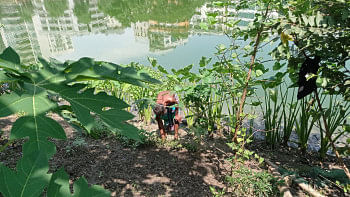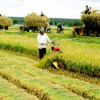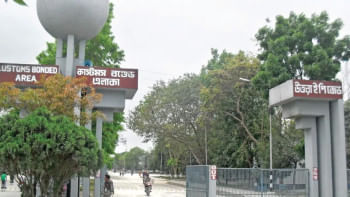Circular agricultural platform can benefit farmers and consumers

In Bangladesh, farmers do not get fair prices for their harvest and consumers do not get access to quality food at reasonable prices, both because of the existing dysfunctional marketing channel, which includes many layers of value chain actors who are commonly known as middlemen. To address this issue, developing a circular agricultural innovation platform can help both farmers and consumers to avail fair market prices. This can be actualised only if we can create an agricultural ecosystem and a supporting infrastructure for the platform.
Innovation is not necessarily something novel; rather, it is something that creates value for consumers. In the agricultural sector, innovation can be producing quality foods, higher yield, vertical farming, precision agriculture that increases soil quality and productivity, faster delivery to the consumer end, storing, processing, preparing and marketing of quality foods at reasonable prices to consumers, etc. An innovation platform is a virtual place that enables value creation. This platform brings together producers, consumers, and other stakeholders—for example, distributors, processing organisations, policymakers, regulatory authorities, etc—and helps them identify common problems and market needs while also creating opportunities for new stakeholders to emerge. For instance, consumers demanding organic foods would necessitate organic feed for poultry, organic manure for soil, and delivery with a low carbon footprint. Entrepreneurs can find opportunities to fulfil these necessities by establishing sustainable companies.
In sustainable development literature, circular economy is defined as a regenerative system for which the main principles are: to eliminate waste and pollution; to extend the life of the products through reuse, recycling, repair, and remanufacture; and to use renewable resources to replenish the ecosystem. In simpler words, in a circular economy, waste and resources are recycled, recreated, reconstructed, and reconfigured into new products to achieve zero waste. For example, cow dung can be used to produce organic manure, which can then be used to fertilise lands for crop production, or food waste can be used to create compost or rice husk ash, a byproduct produced by burning rice grain husks that can be used to produce energy to power a manufacturing facility. These examples show that circular practices are not new in Bangladesh.
However, over the last few decades, organic practices have been replaced by more non-organic ones. Thus, developing a circular agricultural innovation platform would connect farmers and consumers without having too many value chain actors competing with each other, ensuring fair prices for farmers and better value for consumers. It will ensure zero waste by coordinating the exchange of resources among different value creators, e.g. farmers, poultry and fish harvesters, green fertiliser and pesticide companies, seed and food processing centres, recycling centres, groceries, and consumers. It can also enable national and international actors to contact the farmers directly without the intervention of any middlemen. It will also enable research centres and universities to create and apply knowledge in the related field and for future education and research, and allow entrepreneurs to capture opportunities by establishing sustainable companies.
The platform will be self-sufficient and self-sustaining as the stakeholders would benefit each other within a circular economic system. The stakeholders will be connected through a virtual platform, a web account, and/or a smartphone application to carry out the activities. This application would be used to increase production and promote and market fresh and processed food items to consumers.
There must be a physical platform as well in the form of an outlet, storage, processing, and packaging facility connected with this virtual platform. Farmers will bring their produce to the outlet to sell at market prices. They can leave their produce at the storage, processing, and packaging centre located close to the outlet that can be delivered to faraway markets. The physical platform must be owned by the farmers collectively. Owning the centre will increase the bargaining power of the farmers, reduce the power of different levels of arotdar (warehouse agents), and create a competition with large food processing companies/retailers. Consequently, it will force innovation and quality enhancement, encourage consumers to buy from the "nearby" market, and in the process will also help reduce carbon footprint.
How will the platform function?
Initially this platform should be developed covering a small area, including some villages under one upazila. If the model succeeds, this can be scaled up. The platform will need a smartphone application developer, an IT and website manager, outlet managers, employees to work in the outlet, a trainer, a processing centre manager, social business investors, and researchers from different fields of agriculture, marketing, and engineering to help build the ecosystem to make the platform functional.
Firstly, upazila storage and food processing and packaging facilities will be developed where farmers will store their produce, process them, and package them. For example, they can wash, dry, and pack them, set a price, and make them ready for dispatch to other locations.
Secondly, there will be auction-based marketing of products from the outlet, so the profit from the produce at this centre will go directly to the farmers. Farmers will be able to upload information and photos of their produce on the app. Retailers and individual customers can contact the farmers directly through this app, unless they use their contract farmers while also having direct access to the produce at the outlet.
As we know, when supply is abundant, it decreases the bargaining power of the producer since consumers have options to choose from. Hence, farmers can produce certain items to maintain the demand and supply balance by the agricultural officers.
Now, the most important part of this platform is to use the wastes of the post-harvest and pre-market processing of products through recycling. This can create opportunities for entrepreneurs to start recycling companies. This platform can encourage entrepreneurial activities in food processing, green fertiliser, green pesticides, energy, recycling, and the waste sector. Public-private partnerships can be encouraged, too.
Additionally, this platform will support all forms of organised training programmes of the government agencies, research organisations and NGOs, and can be the hub of agricultural transformation, from individual level to group or community level, giving a better bargaining power to the producers for better prices on their investment.
If this works at the upazila level, an extended platform at the district level can be developed to ensure faster market access from where produce can be transported to other markets.
In many advanced countries, innovation platforms exist, which enable interaction among producers and customers, allow different stakeholders to come and share information, ideas and resources, and play a significant role in creating opportunities for entrepreneurial activities to begin, shape up policies and regulations, and develop supporting infrastructure for entrepreneurial activities. Bangladesh may not be an advanced country yet and may have a number of challenges, but it is possible to develop a platform like this that can bring a fundamental change in the lives of the marginal farmers—if, and only if, we can turn this idea into practice.
Dr Sabrina Luthfa is senior lecturer at the University West, Sweden, and lecturer at the STARS EU. She can be reached at [email protected].
Views expressed in this article are the author's own.
Follow The Daily Star Opinion on Facebook for the latest opinions, commentaries, and analyses by experts and professionals. To contribute your article or letter to The Daily Star Opinion, see our guidelines for submission.

 For all latest news, follow The Daily Star's Google News channel.
For all latest news, follow The Daily Star's Google News channel. 









Comments